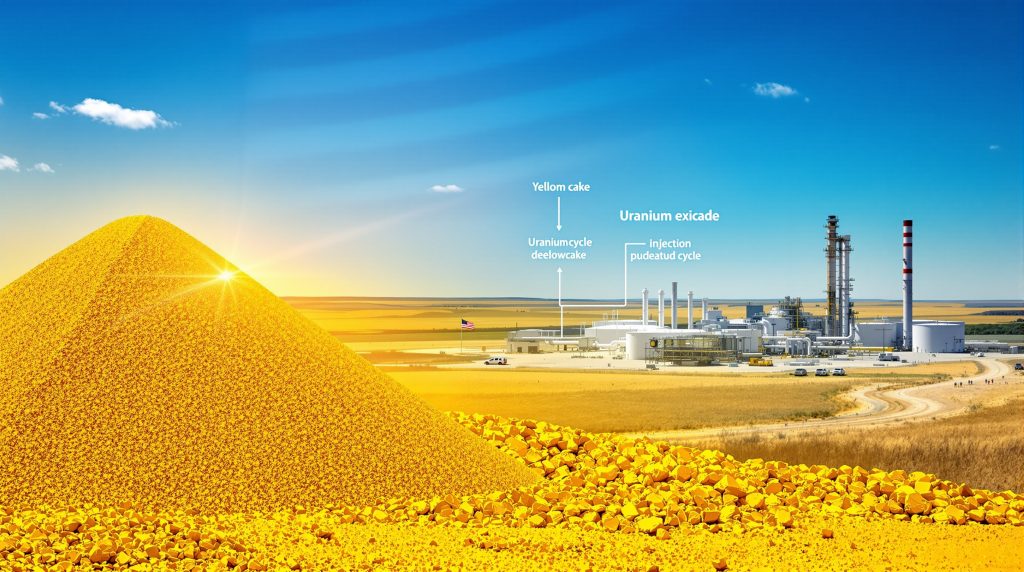Peninsula Energy's Yellowcake Production: A Milestone for US Uranium Supply
What is Yellowcake Production and Why Does it Matter?
Yellowcake uranium represents a critical intermediate product in the nuclear fuel cycle, typically containing between 80-90% uranium oxide (U₃O₈). Despite its name, modern yellowcake varies in color from olive green to dark gray, depending on processing methods and impurities present.
The production of yellowcake marks a crucial transition point where raw uranium ore is concentrated into a form suitable for further processing. For uranium mining companies, achieving consistent yellowcake production represents a significant operational milestone that demonstrates technical capability and opens revenue generation opportunities.
Nuclear power plants worldwide depend on a reliable supply chain that begins with yellowcake production. The material undergoes conversion to uranium hexafluoride (UF₆), enrichment to increase the concentration of uranium-235, and finally fabrication into fuel assemblies used in nuclear reactors.
For Peninsula Energy, yellowcake production at its Lance Project represents years of development work coming to fruition, positioning the company among the select group of active uranium producers in the United States.
How Does Peninsula Energy's Lance Project Create Yellowcake?
In-Situ Recovery Technology Explained
The Lance Project in Wyoming utilizes in-situ recovery (ISR) mining, a specialized extraction method that differs fundamentally from conventional mining approaches. Unlike traditional open-pit or underground mining that physically removes ore, ISR works by selectively dissolving uranium minerals where they naturally occur underground.
The ISR process at Lance involves:
- Drilling injection and production wells into uranium-bearing sandstone formations
- Introducing an oxygen-enriched low-pH solution into the deposit through injection wells
- Allowing this solution to circulate through the permeable sandstone, dissolving uranium minerals
- Pumping the uranium-rich solution to the surface through production wells
- Processing the solution to extract and concentrate the uranium
This approach carries several environmental and economic advantages over conventional mining. The method minimizes surface disturbance, produces no waste rock or tailings, and typically has lower capital and operating costs. The Lance Project specifically employs low-pH chemistry, which has demonstrated improved uranium recovery rates compared to the alkaline chemistry previously used at the site.
Central Processing Plant Capabilities
At the heart of Peninsula's yellowcake production system stands its central processing plant (CPP), a sophisticated facility designed to transform uranium-rich solutions from wellfields into market-ready yellowcake powder.
The Lance CPP features:
- Multiple processing circuits including ion exchange, elution, precipitation, and drying
- Annual processing capacity of up to 2 million pounds of yellowcake at full operation
- Advanced instrumentation and control systems for quality assurance
- Environmental monitoring equipment to ensure regulatory compliance
- Modular design allowing for staged capacity expansion
The plant employs a series of technical processes where uranium-loaded resin from satellite ion exchange facilities undergoes elution (stripping uranium from the resin), followed by precipitation of uranium oxide, and finally drying and packaging of the yellowcake product. This full-cycle processing capability gives Peninsula greater control over product quality and production timing compared to companies that must ship loaded resin to third-party processors.
When Did Peninsula Energy Begin Yellowcake Production?
Timeline of Production Milestones
Peninsula Energy's path to yellowcake production has been marked by several key milestones, technical adjustments, and market-driven decisions:
| Date | Milestone |
|---|---|
| 2015-2019 | Initial production at Lance using alkaline leaching technology |
| 2020 | Strategic decision to transition to more efficient low-pH ISR process |
| 2020-2023 | Production hiatus for retooling and regulatory approvals |
| December 2024 | Restart of uranium recovery operations with resin loading |
| January 2025 | Announcement of production delays affecting initial targets |
| September 2025 | First yellowcake production achieved at Lance Project |
The company's production journey has been notably complicated by its decision to transition from alkaline to low-pH ISR technology. While this change promised improved recovery rates and economics, it required extensive retooling, additional permitting, and a complete operational restart.
The September 2025 announcement of first yellowcake production represents a pivotal achievement following these challenges, potentially marking a turning point for the company's operational trajectory.
Regulatory Approvals and Production Ramp-Up
Peninsula's production timeline has been significantly influenced by regulatory requirements specific to uranium mining in Wyoming. The state's Uranium Recovery Program, administered through the Wyoming Department of Environmental Quality, maintains strict oversight of all uranium production activities.
Key regulatory considerations that shaped Peninsula's production timeline included:
- Amendment of existing permits to allow low-pH chemistry
- Staged approvals for wellfield development and uranium recovery
- Environmental monitoring requirements during operational transitions
- Demonstration phase requirements to validate new technical approaches
The production ramp-up following initial yellowcake production typically follows a phased approach, with gradual increases in wellfield development and processing capacity. Peninsula's initial production guidance for 2025 targeted approximately 600,000 pounds, though this was subsequently revised following operational challenges.
What Challenges Has Peninsula Energy Overcome?
Market and Operational Hurdles
Peninsula Energy has navigated a complex landscape of technical, financial, and market challenges on its path to yellowcake production:
- Share price volatility with a dramatic decline from over $1.50 in October 2024 to approximately 30 cents by September 2025
- Production delays announced in January 2025 that necessitated guidance revisions
- An extended five-month ASX trading suspension until late August 2025
- Leadership transitions including the departure of the company chair in April 2025
- Technical challenges associated with the transition to low-pH ISR technology
- Supply chain constraints affecting equipment availability and operational timing
The company's share price performance has reflected these challenges, with one-year returns down 73% as of September 2025, despite the positive news of first yellowcake production.
Peninsula's experience mirrors challenges faced by other uranium producers, including Boss Energy, which encountered similar production delays and leadership changes during the same period. These issues highlight the broader uranium market volatility affecting producers globally.
Strategic Pivots
In response to these challenges, Peninsula implemented several strategic adjustments to its business model and operational approach:
- Transition from outsourced processing to complete in-house yellowcake production
- Revised operational timelines that acknowledged technical and supply chain realities
- Enhanced investor communications following regulatory scrutiny over guidance practices
- Leadership restructuring to better align with production phase requirements
- Modified wellfield development sequencing to optimize initial production performance
These strategic adjustments, while necessary, contributed to timeline extensions and increased investor uncertainty. However, they ultimately positioned the company to achieve sustainable yellowcake production with improved operational control.
Why Is US Domestic Uranium Production Significant?
Energy Security Implications
The resumption of yellowcake production at Peninsula's Lance Project carries strategic significance that extends beyond the company's commercial interests:
- Reduces dependence on imported uranium, which currently accounts for approximately 95% of US nuclear fuel supply
- Supports the US strategic uranium reserve initiative announced in 2025 under the Trump administration
- Aligns with bipartisan policy objectives for strengthening domestic critical mineral supply chains
- Creates resilience against geopolitical disruptions affecting international uranium markets
- Maintains technical capabilities and workforce skills in the domestic uranium sector
The US nuclear fleet generates approximately 20% of the nation's electricity while producing no carbon emissions during operation. This makes a secure uranium supply chain an important component of both energy security and climate policy.
The US Senate uranium ban on Russian imports has further highlighted the importance of developing domestic supply sources. Furthermore, the strategic uranium reserve initiative announced in 2025 specifically aims to create a stockpile of domestically-produced uranium to guard against supply disruptions and support the US commercial nuclear fleet.
Market Positioning for Peninsula Energy
Beyond national security implications, the timing of Peninsula's yellowcake production coincides with favorable market dynamics:
- Growing recognition of nuclear energy's role in clean energy transition strategies
- Rising uranium spot prices improving project economics for producers
- Increasing investor interest in uranium equities with US exposure
- Limited number of active US uranium producers creating scarcity value
- Potential premium pricing for US-origin uranium under certain government programs
These market factors create potential tailwinds for Peninsula as it establishes consistent production volumes. The company's Wyoming location also provides logistical advantages for serving US nuclear utilities compared to international suppliers, particularly in light of ongoing US uranium market disruption from policy changes.
What Does Peninsula Energy's Future Production Outlook Include?
Production Targets and Expansion Potential
The Lance Project provides Peninsula with substantial room for production growth beyond initial yellowcake output:
- JORC-compliant resource of 58 million pounds of U₃O₈
- Multiple identified mining units suitable for sequential development
- Permitted capacity for up to 2 million pounds of annual production
- Potential for resource expansion through additional exploration
- Modular infrastructure allowing for staged capacity increases
Peninsula's approach to production expansion emphasizes capital efficiency through phased development. Initial production focuses on higher-grade portions of the resource, with subsequent mining units being developed as production and cash flow stabilize.
The company's permitted capacity significantly exceeds initial production levels, creating a clear pathway for output growth as operational experience increases and market conditions warrant expansion.
Financial Positioning
Peninsula has undertaken several financial initiatives to support its production objectives:
- A$69.9 million capital raising completed to fund restart operations
- US$54 million secured for production ramp-up activities
- Potential for reduced operating costs through vertical integration
- Improved margins through elimination of third-party processing fees
- Multiple uranium sales contracts providing revenue visibility
The transition to full in-house yellowcake production represents an important financial milestone for the company, eliminating costs associated with third-party processing and potentially improving product margins. However, the extended timeline to production has consumed financial resources, making efficient operations critical to future success.
How Has the Market Responded to Peninsula's Production News?
Investor Sentiment Shifts
The announcement of first yellowcake production has begun to shift market perception, though significant challenges remain:
- 7% share price increase following the September 2025 production announcement
- Trading at approximately 30 cents per share, compared to over $1.50 in October 2024
- One-year returns showing a 73% decline despite recent positive news
- Increasing trading volume suggesting renewed investor interest
- Continued concern about production consistency and financial sustainability
The market response indicates cautious optimism tempered by recognition of the challenges Peninsula has faced. Investors appear to be taking a wait-and-see approach regarding the company's ability to maintain consistent production and achieve economic viability.
Analysts note that successful uranium producers typically demonstrate a pattern of consistent production growth and clear communication regarding operational metrics, areas where Peninsula will need to build credibility following its extended production delays and guidance revisions.
Peer Comparison
Peninsula's production news comes amid broader sector movements affecting uranium equities:
- Similar production challenges reported by peer companies like Boss Energy
- Rising tide for uranium equities as US strategic reserve announcements boost sector
- Differentiation through actual production achievement versus development-stage peers
- Competitive positioning as one of few active US uranium producers
- Relative valuation metrics suggesting potential upside if production targets are achieved
The uranium sector has seen increased investor interest following announcements regarding the US strategic uranium reserve, creating potential tailwinds for companies with US production assets. Peninsula's ability to differentiate itself through consistent production could improve its relative positioning within this peer group, especially with the recent Paladin uranium halt at Langer Heinrich further tightening supply.
What Are the Environmental Considerations of Yellowcake Production?
Regulatory Compliance
Peninsula's operations are subject to comprehensive environmental oversight:
- Wyoming Department of Environmental Quality monitoring and inspection
- Groundwater restoration requirements following mining operations
- Regular environmental reporting and compliance verification
- Bonding requirements to ensure site restoration after production concludes
- Strict protocols for handling and transporting uranium products
These regulatory requirements create a structured framework for environmental protection throughout the production lifecycle. Wyoming's uranium regulatory program is among the most developed in the United States, with decades of experience overseeing ISR operations.
The regulatory approach emphasizes groundwater protection, with extensive monitoring networks established before, during, and after production to ensure aquifer conditions are maintained or restored. Financial assurance mechanisms ensure funds are available for proper site closure regardless of the company's financial status.
Sustainability Factors
The ISR mining method employed at Lance offers several environmental advantages:
- Minimal surface disturbance compared to conventional mining
- No waste rock or tailings produced at the mine site
- Lower water consumption than conventional mining methods
- Reduced dust and air quality impacts
- Smaller overall environmental footprint
These advantages make ISR mining generally considered among the more environmentally responsible approaches to uranium extraction. However, the process still requires careful management to protect groundwater resources and ensure proper restoration following production.
Peninsula's transition to low-pH ISR technology also has environmental implications, with the lower pH chemistry requiring additional monitoring and control measures compared to alkaline systems, but potentially offering more complete groundwater restoration.
How Does Peninsula's Yellowcake Production Impact the Global Uranium Market?
Supply Chain Implications
While modest in global terms, Peninsula's production contributes to uranium supply dynamics:
- Diversifies global uranium sources in a market dominated by state-controlled enterprises
- Adds to Western-aligned production capacity
- Increases the limited number of publicly-traded uranium producers
- Supports nuclear fuel supply for existing and planned reactors
- Represents a potential stepping stone to more significant US production
The global uranium market has experienced significant supply constraints, with production cuts from major producers like Kazatomprom and Cameco creating a more balanced market following the post-Fukushima oversupply period. Peninsula's production enters this tightening market as nuclear energy gains renewed attention for its zero-carbon generation capabilities.
Market Significance
Peninsula's market significance extends beyond its immediate production volumes:
- One of few active uranium producers on the ASX
- Contributes to US domestic supply objectives
- Provides investment exposure to physical uranium production
- Represents a potential turnaround story following operational challenges
- Serves as a bellwether for the viability of US uranium production
The company's progress through technical challenges and market volatility provides valuable insights into the economics of US uranium production under current market conditions. Its success or continued challenges will influence investor perceptions of the broader uranium recovery thesis and uranium investment insights more generally.
What Should Investors Consider About Peninsula Energy?
Risk Factors
Potential investors should weigh several considerations when evaluating Peninsula Energy:
- History of production delays and guidance revisions affecting credibility
- Significant share price volatility with 73% decline over the past year
- Execution risks in scaling production to commercial levels
- Sensitivity to uranium market price fluctuations
- Potential for additional capital requirements if production ramp-up is extended
- Competitive pressures from larger, established uranium producers
The company's pattern of operational challenges and communication issues suggests a need for sustained operational execution to rebuild market confidence. While first yellowcake production represents an important milestone, consistent production at economically viable levels will be necessary to support long-term value creation.
Potential Catalysts
Several factors could influence Peninsula's future performance:
- Achievement of consistent commercial production levels
- Updated production guidance and delivery against targets
- Uranium price movements affecting project economics
- US policy developments regarding domestic uranium supply
- Potential strategic partnerships or offtake agreements
- Resource expansion through additional exploration success
The broader uranium market context also provides potential tailwinds, with growing recognition of nuclear energy's role in climate solutions and increased government support for secure supply chains. If Peninsula can establish operational credibility through consistent execution, it may benefit substantially from these sector-wide trends.
FAQ: Peninsula Energy's Yellowcake Production
What is yellowcake uranium?
Yellowcake uranium is a concentrated powder form of uranium oxide (U₃O₈) that serves as an intermediate product in the nuclear fuel cycle. Despite its name, modern yellowcake typically ranges from olive green to dark gray in color and contains approximately 80-90% uranium oxides.
How does Peninsula Energy produce yellowcake?
Peninsula uses in-situ recovery mining at its Lance Projects in Wyoming, injecting an oxygen-enriched solution into uranium-bearing sandstone formations. The uranium-rich solution is then processed through ion-exchange systems and multiple processing circuits to create the final yellowcake product.
Where is the Lance Project located?
The Lance Project is located in Wyoming, USA, which has a long history of uranium production and a well-established regulatory framework for uranium mining operations.
What is Peninsula Energy's production capacity?
Peninsula's central processing plant has the capacity to produce up to 2 million pounds of yellowcake annually at full operation, though initial production targets are more modest as operations ramp up.
How does Peninsula's production compare to global uranium supply?
While Peninsula's production represents a small fraction of global uranium supply (approximately 140 million pounds annually), it is significant as one of the few active uranium producers in the United States.
What factors affect yellowcake production costs?
Production costs are influenced by several factors including wellfield performance, recovery rates, reagent consumption, labor costs, regulatory compliance expenses, and economies of scale as production volumes increase.
Further Exploration:
Readers interested in learning more about uranium market dynamics and production can also explore related educational content at The Market Online, which offers regular updates on developments in the uranium and broader resources sector.
Disclaimer: This article contains information of a general nature only and is not intended as investment advice. Market conditions and company circumstances can change rapidly, potentially affecting investment outcomes. Readers should conduct their own research and consult financial advisors before making investment decisions.
Want to Discover the Next Big Mineral Find Before the Market?
Gain immediate insights on significant ASX mineral discoveries with Discovery Alert's proprietary Discovery IQ model, turning complex exploration data into actionable investment opportunities. Visit the Discovery Alert discoveries page to see how major finds can generate substantial returns and begin your 30-day free trial today.



